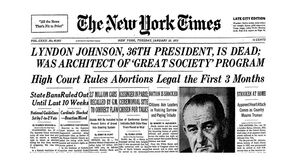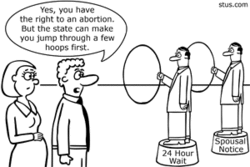Difference between revisions of "How does Planned Parenthood vs. Casey differ from Roe v. Wade"
| Line 1: | Line 1: | ||
| − | [[File:159081-nytrvw.jpg|thumbnail|left| | + | [[File:159081-nytrvw.jpg|thumbnail|left|300px|This is an image of the ''New York Times'' after the ''Roe'' decision.]] |
__NOTOC__ | __NOTOC__ | ||
Beginning in the late 1960s, individual states began to challenge and decriminalize abortion laws, and in 1970, some of the first states began to legalize it. While states’ actions began to form a patchwork of abortion legislation, the issue had not been resolved at the federal level. This would change in 1973 with the Roe v. Wade decision. Since 1973, most Americans reference Roe when discussing abortion legislation; however, there have been legal challenges to Roe since then. These legal challenges that followed have changed the legal landscape—meaning, abortion rights are no longer as defined by the Roe decision, as they are by others like Planned Parenthood vs. Casey. | Beginning in the late 1960s, individual states began to challenge and decriminalize abortion laws, and in 1970, some of the first states began to legalize it. While states’ actions began to form a patchwork of abortion legislation, the issue had not been resolved at the federal level. This would change in 1973 with the Roe v. Wade decision. Since 1973, most Americans reference Roe when discussing abortion legislation; however, there have been legal challenges to Roe since then. These legal challenges that followed have changed the legal landscape—meaning, abortion rights are no longer as defined by the Roe decision, as they are by others like Planned Parenthood vs. Casey. | ||
Revision as of 21:27, 28 September 2021
Beginning in the late 1960s, individual states began to challenge and decriminalize abortion laws, and in 1970, some of the first states began to legalize it. While states’ actions began to form a patchwork of abortion legislation, the issue had not been resolved at the federal level. This would change in 1973 with the Roe v. Wade decision. Since 1973, most Americans reference Roe when discussing abortion legislation; however, there have been legal challenges to Roe since then. These legal challenges that followed have changed the legal landscape—meaning, abortion rights are no longer as defined by the Roe decision, as they are by others like Planned Parenthood vs. Casey.
Roe v. Wade
In 1969, a young woman named Norma McCorvey discovered she was pregnant. McCorvey wanted to terminate her pregnancy, but abortion was only legal under limited circumstances in her home state of Texas. She had no illness or disease that would legally allow her to abort, so the only other option was to claim that her pregnancy was the result of the rape. However, since there were no police reports documenting the rape, there was no proof that the rape had happened, and there were no legal options available to her. McCorvey then attempted to acquire an illegal abortion, but police shut down the clinic before she could go in for the procedure.
Out of options, McCorvey took the alias Jane Roe and brought about legal action against Henry Wade, the District Attorney in Dallas, Texas (where she lived). Using some of the arguments that had been made in the legal challenges to abortion statutes in the previous few years, Roe argued that Texas’ abortion statute violated her constitutional rights. She and her legal counsel argued that requiring her life to be in danger in order to get a legal abortion violated her rates. She also argued that she had a right to safe abortion, even if she could not afford to leave her state. Finally, Roe and her attorneys claimed that the Texas abortion statute was “unconstitutionally vague,” and that it violated her first, fourth, fifth, ninth, and fourteenth amendment rights.
The court agreed with Roe to an extent. However, instead of recognizing a blanket right to abortion, the court developed the trimester system. According to the Court, since the medical community argued that the fetuses could be viable after six months, the court believed that states could intervene to protect fetal rights after that point, while also providing an exception for maternal life. Before viability, the Court ruled it did not have enough of an interest in the embryo to stop women from acquiring abortions. And with that, abortions became legal in the United States.
There were immediately a number of challenges to the Roe decision. While many of these other cases and acts did shift abortion rights and legislation, it wasn’t until Planned Parenthood vs. Casey that these dramatically altered the landscape for legal abortion.
Planned Parenthood vs. Casey
In 1989, Pennsylvania Governor Bob Casey signed the Abortion Control Act. This was one of the first attempts by an individual state to restrict abortion rights after Roe. The Act had several provisions that were designed to limit abortions: informed consent, spousal notification, parental notification, a 24-hour waiting period, and clinics would be required to report to the state demographic data of women acquiring abortions.
When Casey signed the Act, it was immediately challenged by a number of abortion providers, counselors, and doctors—turning into the class action lawsuit: Planned Parenthood of Southeastern Pennsylvania vs. Casey.
It was 1992 by the time this case made its way to the U.S. Supreme Court. The attorneys for the appellants argued that Pennsylvania’s Abortion Control Act effectively overturned Roe since it imposed so many regulations on both the women getting abortions, and the doctors providing them. However, the attorneys for the defendants argued they were not overturning Roe, they were simply asking to be judged by an “undue burden” test.
It is important to note that the U.S. Supreme Court had already decided that the existence of a fundamental right (like abortion) and the enjoyment of a fundamental right were mutually exclusive; and that since the state had an interest in potential life, it could favor or encourage pregnancy and childbirth so long as it did not prevent women from getting abortions.
When the decision was announced, the majority held on to the three fundamental tenets of the Roe decision: that women had the right to an abortion before fetal viability, that the state had the right to restrict abortions after viability, and that the state has an interest in protecting the life of the woman and the potential child.
Nevertheless, in their opinions for this case, the majority opted for an “undue burden” standard over the existing trimester system since it was more flexible and reflected the state’s interest in potential life. Instead of allowing all abortions in the first trimester without question, the Court ruled that it was acceptable for states to introduce efforts to restrict abortions at any point during the pregnancy, so long as women were not denied abortions. Additionally, the majority felt that Pennsylvania’s abortion regulations (with the exception of spousal notification) did not violate the constitution and did not constitute “undue” burdens.
In moving from the trimester system—based on a calendar—to a system based in determining whether abortion regulations were “undue burdens,” the decision to have an abortion moved away from the doctor-patient relationship and back into the courts where they were subject to legal interpretation: specifically, any state could introduce new legislation to restrict abortion, and then it would only be up to individuals to challenge these restrictions by stating and proving that they were unduly burdensome.
Although abortion remained legal in the U.S. the ruling allowed for the creation of new regulations that severely limited abortions, or at least made them more inconvenient.
Since the decision, a number of states began to follow Pennsylvania’s example by implementing their own abortion restrictions. Typically, these restrictions involve certain standards for clinics that provide abortions (requiring hospital privileges or doctors, requiring that hallways be a certain width, or even requiring that clinics are a certain distance from schools), waiting periods, mandated counseling, vaginal ultrasounds, or requiring women to listen to the fetal heartbeat.
To an extent, those who are pro-choice and those who are pro-life both saw the decision in Planned Parenthood vs. Casey as a win. While women maintained their rights to acquire abortions, the decision ultimately created greater opportunities for states to chip away at those rights, and to create barriers that disproportionately affect young women, poor women, women of color, and rural women.
References
ROE ET AL. v. WADE, DISTRICT ATTORNEY OF DALLAS COUNTY. 410 U.S. 113 (1973).
PLANNED PARENTHOOD OF SOUTHEASTERN PENNSYLVANIA, ET AL v. CASEY, Robert P. ET AL. 947 F.2d 682 (1991).
N.E.H. Hull & Peter Charles Hoffer, Roe v. 2ade: The Abortion Rights Controversy in American History, Second Edition (Lawrence: University Press of Kansas, 2010).

